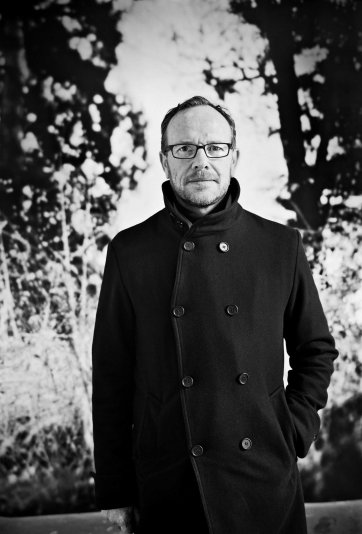The Chairman, Board, Director and staff of the National Portrait Gallery mourn the loss of Andrew Sayers AM FAHA, the Gallery’s inaugural Director (1998‒2010), who died in Melbourne on Sunday evening. He was only 58.
Andrew Sayers was born in England and came to Australia with his parents at the age of six. He grew up in the Hawkesbury region. A keen artist and observer of nature from boyhood, he formed a precocious determination to become an art historian and in 1979 graduated with honours in Art History from the University of Sydney. Having been Registrar of Collections at The Art Gallery of New South Wales, in 1981 he became Assistant Director at the Newcastle Region Art Gallery. In 1985 he moved to Canberra to take up the position of Curator of Australian Drawings and then Assistant Director (Collections) at the National Gallery of Australia. In 1989 he published Drawing in Australia, and in 1994 Aboriginal Artists of the Nineteenth Century, an important, ground-breaking work of scholarship for which Andrew received the H. E. Stanner Award of the Australian Institute of Aboriginal and Torres Strait Islander Studies (AIATSIS).
Andrew Sayers was appointed inaugural Director of the new National Portrait Gallery in April 1998. While committed to the Gallery's development as a centre for biography and history, Sayers established the progressive character of the institution with an exhibition The Possibilities of Portraiture (1999), comprising a mixture of historical and contemporary works in various media. As the title suggests, Andrew envisioned a National Portrait Gallery that not only told the story of Australia through portraits of its most eminent citizens, but also pushed at the very boundaries of the genre of portraiture itself.
In his first year at the Gallery – whilst writing, in the very early mornings, Australian Art for the Oxford History of Art series – he established policies, made press appearances, commissioned new works of art, conceived exhibitions, wrote acquisition proposals for individual works and researched, wrote and edited text for display in the Gallery. It is given to very few art museum directors to be responsible, together with successive chairs – Marilyn Darling AC and Tim Fairfax AC – and advisory boards, with whom he worked so closely and effectively, to establish the entire working framework of a brand new institution, to set its agenda, and cause it to flourish as Andrew Sayers did.
In June 2000, after six gruelling months of international negotiation, he secured John Webber’s portrait Captain James Cook, RN at a cost of $5.3 million. That splendid acquisition did much to announce the arrival of an ambitious national collecting institution, which has since grown apace and, less than twenty years on, consists of more than 2,400 portraits.
Over eleven years, during which the staff of the Gallery increased fivefold, he conceived or worked in partnership to create the exhibitions Arthur Boyd Portraits (1999‒2000); Heads of the People (2000); Nolan Heads (2001); Intimate Portraits (2002); Contemporary Australian Portraits (2002‒03); POL: Portrait of a Generation (2003); To Look Within: Self-Portraits in Australia (2004); The World of Thea Proctor (2005); Clifton Pugh Australians (2005‒06) and Open Air: Portraits in the Landscape (2008). At the same time, from 2003 onward he argued for a dedicated building for the National Portrait Gallery – which was promised in 2004, commenced in 2006 and opened at the end of 2008. In 2010 he was awarded the AM “for services to arts administration, particularly as the Director of the National Portrait Gallery, and to the promotion of Australian portraiture.” In 2013 Andrew was elected a Fellow of the Australian Academy of the Humanities.
In 2010, Andrew Sayers left the National Portrait Gallery to take up the position of Director of the National Museum of Australia, serving in that capacity until, at length, in 2013 he decided to devote himself full-time to painting in the studio. A fine portrait of his close friend Professor Tim Bonyhady was selected for inclusion in this year’s Archibald Prize exhibition at The Art Gallery of New South Wales, the institution where Andrew began his career.
Our colleagues (and his) at the National Gallery of Australia and the National Museum of Australia, meanwhile, will share our profound sense of loss, and surely join us in extending our sincere condolences to Andrew’s wife Perry, their daughters Ianthe, Hana and Ella, and their grandchild Asher, and the many friends and colleagues throughout Australia and much farther afield whose lives he touched.
We last saw Andrew Sayers at the memorial service in Melbourne to celebrate the life of the late L. Gordon Darling AC CMG, the Gallery’s Founding Patron with whom he worked so closely to establish this institution. That Andrew made the colossal effort to be present on that occasion, so very aware of the gravity of his own illness, was an unforgettable demonstration of the undaunted character of the man.
Though he died far too soon, Andrew Sayers achieved great things. His fine books will long continue to inspire future generations of scholars of Australian art.
Dr Helen Nugent AO
Chairman
Angus Trumble
Director














